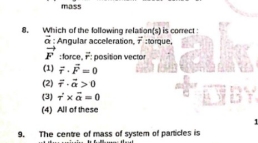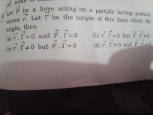CBSE Class 11-science Answered
iN parallel axis theo
MI=sigma m .sq(d+x)
=sigma m.sq(d) +sigma m.sq(x) + 2d sigma(x)
=m.sq(d) + Icg +0
why is 2d sigma(x)=0
Asked by timesnow | 21 Nov, 2010, 11:22: PM
Dear student
A/C parallel axis theorem,
I = Ig + Md2
I = Σm ( x2 + d2 + 2dh)
= Σmx2 + Σmd2 + Σ2mdh............(i)
Now if the body rotates about a given axis such that the chosen particle rotates in a circle of radius x;
Ig = Σmx2
Σmd2 = d2 Σm = Md2
The term, Σ2mxd = 2d Σmx
'Σmx' is a quantity which is proportional to the sum of moments of weights of various particles about the center of gravity G. Since a body can be balanced about its center of gravity ,
2d Σmx = 0
and substituiting this value in eqn (i) , we have
I = Ig + Md2
We hope this clarifies your doubt.
Regards
Team
Topperlearning
Answered by | 23 Nov, 2010, 01:33: PM
Concept Videos
CBSE 11-science - Physics
Asked by rustampathan | 25 Feb, 2024, 06:39: PM
CBSE 11-science - Physics
Asked by gipaalsy | 08 Feb, 2024, 05:41: AM
CBSE 11-science - Physics
Asked by priyankaprajapti81 | 04 Nov, 2023, 10:47: PM
CBSE 11-science - Physics
Asked by gdeadshot85 | 14 Jan, 2023, 09:58: PM
CBSE 11-science - Physics
Asked by devanshchauhan325 | 23 Dec, 2022, 07:34: AM
CBSE 11-science - Physics
Asked by koushtubhroy | 20 Dec, 2022, 07:36: AM
CBSE 11-science - Physics
Asked by pushpakumari291279 | 20 Aug, 2022, 08:15: AM
CBSE 11-science - Physics
Asked by adipadmakarri | 26 Sep, 2021, 06:08: PM
CBSE 11-science - Physics
Asked by adipadmakarri | 25 Sep, 2021, 11:18: AM









